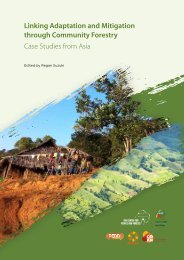Desktop Study on - Regional Climate Change Adaptation ...
Desktop Study on - Regional Climate Change Adaptation ...
Desktop Study on - Regional Climate Change Adaptation ...
You also want an ePaper? Increase the reach of your titles
YUMPU automatically turns print PDFs into web optimized ePapers that Google loves.
Assessment of Capacity Gaps and Needs of South East Asia Countries<br />
in Addressing Impacts, Vulnerability and Adaptati<strong>on</strong> to <strong>Climate</strong> Variability and <strong>Climate</strong> <strong>Change</strong><br />
no clear trend shown by all of the selected models<br />
due to the high variability in the precipitati<strong>on</strong>modulating<br />
factor. Based <strong>on</strong> the MMD’s surface<br />
observati<strong>on</strong> stati<strong>on</strong>s data, annual rainfall change<br />
Table_17 Overview <strong>on</strong> natural disasters in Malaysia from<br />
1980 to 2009<br />
Top 5 Natural Disasters in Malaysia, 1980-2009<br />
Type of natural<br />
disaster<br />
Date/year<br />
(percentage) for the periods 2000 - 2007 relative<br />
to the period 1990 – 1999, indicate that west coast<br />
of Peninsular Malaysia has an increase of 6 - 10 %<br />
in rainfall amount, whereas a decrease of 4 – 6%<br />
of rainfall amount over central<br />
No of people<br />
affected<br />
Pahang and coastal Kelantan. As<br />
for East Malaysia, Sarawak has<br />
an increase of 6 – 10 % in rainfall<br />
amount and Sabah has an increase<br />
of more than 10% (MMD, 2009).<br />
Also, more extreme hydrological<br />
c<strong>on</strong>diti<strong>on</strong>s may be expected.<br />
Flood 11 Jan 2007 137533<br />
Flood 19 Dec 2006 100000<br />
Flood 12 Nov 1988 60000<br />
Storm 6 Nov 2004 40000<br />
Flood 23 Nov 2005 30000<br />
Total Natural* Disasters in Malaysia for the period 1980-2009<br />
Type of<br />
natural<br />
disaster<br />
Total no of<br />
events<br />
No of<br />
people<br />
affected<br />
Damage<br />
000 US$<br />
Drought 1 5000 No data<br />
Tsunami 1 5063 500000<br />
Flood 29 535183 1012500<br />
Storm 6 47949 53000<br />
Wild Fire 4 6291 302000<br />
Source: EM-DAT (2009): The OFDA /CRED; Internati<strong>on</strong>al Disaster Database; www.emdat.net<br />
- Université Catholique de Louvain – Brussels, – Belgium.<br />
CLIMATE CHANGE<br />
IMPACTS,<br />
VULNERABILITY<br />
AND ADAPTATION<br />
Water Sector<br />
Malaysia is located within the<br />
humid tropic and has abundant<br />
water resources. Total annual<br />
rainfall is 990 billi<strong>on</strong> m3 while<br />
the annual surface runoff is<br />
approximately of 566 billi<strong>on</strong> m3<br />
– 147 billi<strong>on</strong> m3 in Peninsular<br />
Malaysia, 113 billi<strong>on</strong> m3 in Sabah,<br />
and 306 billi<strong>on</strong> m3 in Sarawak. The<br />
groundwater recharge is estimated<br />
at 64 billi<strong>on</strong> m3 annually, while<br />
the balance 360 billi<strong>on</strong> m3<br />
returns to the atmosphere via<br />
Figure 53: Percentage of people affected<br />
due to total natural disasters<br />
1980-2009<br />
Wildfire 0%<br />
Storm 8%<br />
Drought 1%<br />
Tsunami 1%<br />
Figure 54: Percentage of damage (US$)<br />
due to total natural disasters<br />
1980-2009.<br />
* Not complete data available<br />
Drought 0%<br />
Wildfire 16%<br />
Flood 54%<br />
Tsunami 3%<br />
Flood 90%<br />
Storm 3%<br />
141

















